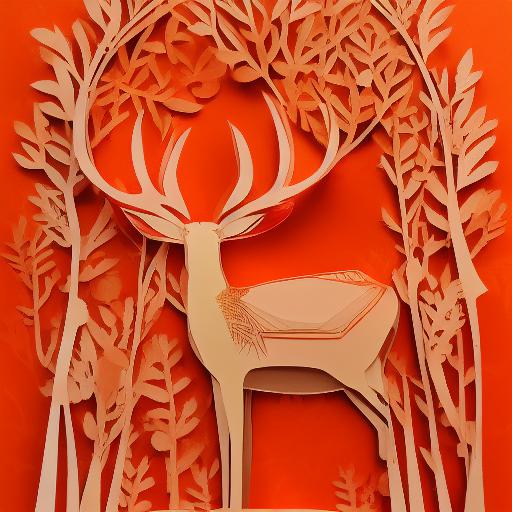How to write this prompt?
To write an AI prompt like the one above, you need to break it down into its individual components and describe each part in detail. Here’s an explanation of each part of the prompt and how it influences the image being generated:
- Layered paper art: This sets the medium for the artwork to be created, indicating that the image will be made using layers of paper. This suggests that the image will have a three-dimensional aspect to it.
- A detailed paper cut of a happy deer in a forest: This provides a specific subject matter for the image. The use of the word “detailed” suggests that the AI should generate a high level of intricacy and attention to detail. The words “happy deer” and “forest” create a mood and setting for the image, indicating that the image should have a positive, peaceful feel and that the deer should be depicted in a natural environment.
- In orange tone: This provides a specific color palette for the image. The use of the word “orange” suggests that the AI should create an image with warm, vibrant tones.
- A storybook illustration by Pál Balkay, Behance contest winner: This provides a reference for the style of the image. The words “storybook illustration” suggest that the image should have a whimsical, narrative quality to it, while the mention of Pál Balkay and Behance indicate a specific artistic style that the AI should emulate.
- Folk art: This further narrows down the style of the image, suggesting that the AI should incorporate elements of traditional, cultural art styles.
- Paper cut art: This reiterates the medium for the artwork, indicating that the image should be created using cut paper.
- 3D flat layered paper shadow box: This provides a specific format for the image. The use of the words “3D” and “layered” suggest that the AI should create an image with depth and dimensionality, while the mention of “flat” and “shadow box” indicate that the image should be contained within a specific frame or format.
Taken together, these individual parts of the prompt provide a detailed set of instructions for the AI to create a layered paper cut image of a happy deer in a forest, in warm orange tones, using a style reminiscent of Pál Balkay’s storybook illustrations and incorporating elements of traditional folk art. The specific format of a 3D flat layered paper shadow box further adds to the specificity of the prompt, indicating that the AI should create an image that fits within a specific frame or display.
What to prepare before making layered paper art?
Before making layered paper art, you will need several materials such as different colored paper, scissors, glue, cutting board, and a precision knife. You can also use a ruler or a pencil to measure and outline your design before cutting. Make sure to choose the right type of paper for your project, depending on the level of detail and thickness of the paper you want to use. It is also helpful to have a clear idea of the design and style you want to achieve before starting the project.
What is layered paper art?
Layered paper art is a three-dimensional art form created by layering cut-out pieces of paper on top of each other to create depth and dimensionality. It is a form of paper cutting that can range from simple to complex designs, with layers of varying thickness and colors. Layered paper art can be used to create shadow boxes, wall art, greeting cards, and other decorative items.
Who is Pál Balkay?
Pál Balkay is an artist and illustrator known for his unique style of layered paper art. He is a Behance contest winner and has won several other awards for his intricate and detailed designs. Balkay’s work is often inspired by traditional folk art and fairy tales, and he is known for his ability to capture a sense of whimsy and narrative in his pieces.
How does AI arts generation contribute to the education world?
AI arts generation can contribute to the education world in several ways. It can help students explore different artistic styles and techniques, providing them with a wider range of creative options. AI-generated art can also be used as a teaching tool, helping to illustrate concepts and ideas in a visual and interactive way. Additionally, AI art generation can make art more accessible to people who may not have the traditional skills or resources to create art themselves, providing a platform for self-expression and creativity.
Is AI arts generation using a trend?
Yes, AI arts generation is a growing trend in the art world. As AI technology becomes more advanced, artists and designers are increasingly using it as a tool for generating new and innovative art. AI-generated art can be found in a variety of mediums, from digital graphics to physical installations. This trend is likely to continue as AI technology continues to evolve, opening up new possibilities for artistic expression and experimentation.
Visual Paradigm Online is a powerful design tool that enables users to seamlessly incorporate AI-generated art into their creative projects. With a user-friendly interface, a wide range of design templates, and a collection of assets and resources, Visual Paradigm Online makes it easy to experiment with different styles and layouts until you find the perfect combination. With the help of this tool, you can create stunning, visually appealing graphics in just a few clicks, making it an essential resource for designers and artists alike.


